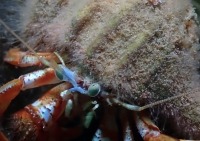
(Photo: Connie Bishop)
Snail Fur
Hydractinia polyclina
This hydroid forms a fuzzy mat about three millimetres thick on shells occupied by hermit crabs. Three types of polyps rise from the mat (feeding polyps, reproductive polyps and stinging polyps). Polyps are pink in colour and can be up to five millimetres high.
Authority
L. Agassiz, 1860
Classification Details
Phylum: Cnidaria (Cnidarians); Class: Hydrozoa (hydrozoans).
Habitat
Usually found on the shells of hermit crabs. However, occasionally found on the underside of rocks. This species was described from Grand Manan in the Bay of Fundy and has been found from the Gulf of St. Lawrence to Maine. Forms a sibling species group with the European species Hydractinia echinata and the more southerly northern American species Hydractinia symbiolongicarpus.
Diet
Predator. Polyps capture small food from the water using stinging cells (nematocysts) on their tentacles to paralyze prey. Prey consists mostly of bottom-dwelling animals such as nematodes and benthic copepods. The medusa stage eats bacteria and small larvae of other invertebrates. They brush food towards the mouth with movements of the bell and tentacles. They also paralyse prey using nematocysts like the polyps.
Reproduction
Sexes are separate with a colony having either male or female reproductive polyps (gonozooids). The colony releases eggs or sperm into the water, where sperm and eggs from different colonies will fertilize each other. After three days the fertilized eggs develop into free-swimming larval form. After a short period, the larva settles onto an elevated location like a stone and adheres to its surface with mucus. If an object moving in fits and starts travels past this stimulates the larvae to release nematocysts and attach to it. Hopefully, it is a hermit crabs shell. It attaches and becomes a polyp. It can then undergo asexual reproduction to create a colony.
Fun Facts
This hydroid gets lots of benefits from living on a hermit crab's shell. Hydroids can’t move by themselves and by living on the back of a crab they have some chance of escaping from their sea slug predators. They also get access to more food. While the crab walks about it drags its shell over the seabed. Then the hydroid's feeding polyps can collect the tiny animals that live in the sediment. Hermit crabs also gather together sometimes which allows the hydroids on their backs to get close enough to mate.
References
Calder DR (2017). Additions to the hydroids (Cnidaria, Hydrozoa) of the Bay of Fundy, northeastern North America, with a checklist of species reported from the region. Zootaxa. 4256(1): 1–86.
Christensen HE (1967) Ecology of Hydractinia echinata (Fleming) (Hydroidea, Athecata) I. Feeding biology, Ophelia, 4:2, 245–275, DOI:10.1080/00785326.1967.10409623
Müller WA, Leitz T (2002) Metamorphosis in the Cnidaria. Canadian Journal of Zoology 80: 1755–1771.
Picton, BE, Morrow, CC (2016). Hydractinia echinata (Fleming, 1828). [In] Encyclopedia of Marine Life of Britain and Ireland. http://www.habitas.org.uk/marinelife/species.asp?item=d3350 Accessed on 2020-11-18
Van Guelpen L, Pohle G, Vanden Berghe E and Costello MJ (2005) Marine Species Registers for the North Atlantic Ocean. World Wide Web electronic publication. http://www.vliz.be/vmdcdata/narms/


